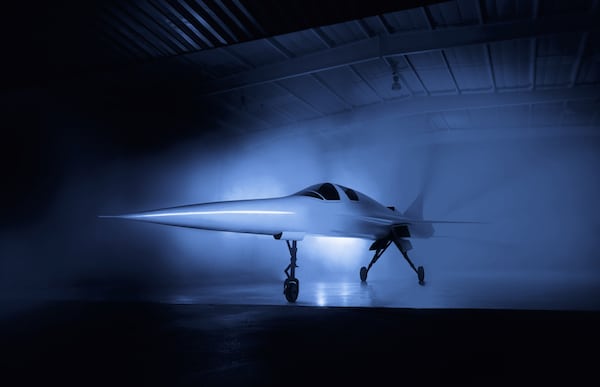
Boom’s supersonic prototype jet. Photo courtesy of Boom
Major aviation industry OEMs are developing supersonic airframes with the goal of re-introducing supersonic flight to passenger carrying aircraft by mid- to late-2020s. Thommen Aircraft CEO Stéphane Jaquier discussed how one of the key avionics components needed to enable supersonic flight is an updated air data computer.
You can find more on supersonic avionics in our June/July issue.
According to the product description for Thommen’s AC32 digital air data computer, the AC32 has “supersonic capability.” Can you explain what the technical explanation for this is?
Thommen has been supplying air data systems for over two decades. Thanks to the variety of installations and applications, we have reused our extensive knowledge in high-precision flight instruments to upgrade our well-known AC32 Digital Air Data Computer by adding the supersonic capability. This upgrade allows us to extend the operational airspeed computation range to Mach Numbers greater than 1.
The principle of airspeed calculation is based on measurements of the impact pressure, which is the difference of total/pitot and static pressure. The calculation of airspeeds depend on the Mach regimes and aerodynamic effects, which are different depending on whether you are flying at subsonic (Ma < 1), transonic (Ma 0.8 < Ma < Ma 1.3), supersonic (Ma > 1.0) or hypersonic (Ma > 5.0) speeds. When flying above Ma > 1, a bow shock is formed in front of the pitot tube, which creates a sudden drop of total pressure. The conventional subsonic formula cannot be applied in such a case to calculate the airspeed, as the total pressure changes across the normal shock. So we needed to apply a supersonic calculation formula, which would take this dynamic effect into account, in order to precisely compute the Mach number and airspeed information. Our software then automatically and constantly checks whether subsonic or supersonic formulas are applicable and selects the applicable Mach number calculation, based on a critical pressure ratio.
What are some of the other primary avionics systems and computers that the air data computer must interact with in order to enable this supersonic capability?
Thanks to its customizable ARINC 429 in- and outputs, it can interface seamlessly with any electronic flight information system or flight management system. We have integrated our products with a large range of digital flight decks. The supersonic AC32 will have the same interface interoperability with these systems, provided they are also suited for supersonic flight operations.
The product sheet mentions that the AC32 has “hosting capabilities that can supply data to other next-generation equipment. It can do all of this without changing the system architecture.” How is this achieved without changing the system architecture?
The AC32 is a fully digital air data unit, which hosts a variety of scalable airspeed computation capabilities, from very low speeds up to supersonic flight conditions. The first version of the AC32 air data computer was introduced in 2006, and we have sold over 3,500 units since then for many different rotorcraft and fixed-wing installations (e.g. A109, A129 Mangusta, AB212, AN-72, AN-124, AS332, AW149, AW189, AW609, C-130, CASA212, DO-228/NG, IL-38/76, KA-62, PC-7/9/12/21, SAAB 105). We even sent our AC32 to space, and made it fly on the Tornado fighter aircraft.
The unit is crafted for precision, as we only use first-quality components and sensors. For this supersonic version, we even added a more robust pitot transducer because we wanted to guarantee the Swiss-made reliability we have been known for since 1853, when we first started to build Thommen watches.
The other good thing is that the addition of the supersonic capability is essentially a software-based modification of the existing subsonic air data computer, hence it does not need any other external sources to enable this function.
Do you get any aftermarket upgrade requests for the AC32, or does most of the demand come from forward fit installations on new aircraft types?
We are pursuing both the forward-fit and retrofit market with the AC32. And the supersonic AC32 now opens even a larger market potential for us. We are looking at older fighters that require new avionics and mission systems. But we are also actively pursuing supersonic UAS opportunities because our product is particularly lightweight.
Is the AC32 being flight tested by any of the major airframe manufacturers who are developing supersonic aircraft, such as Boom or Aerion?
We are in the process of closing several major forward fit military programs, but we are unable to publicly report on those at this point. We are also actively pursuing supersonic UAS opportunities because our product is particularly lightweight. We would be glad to explore civil applications of the supersonic AC32, and we would be thrilled to work with Boom or Aerion.